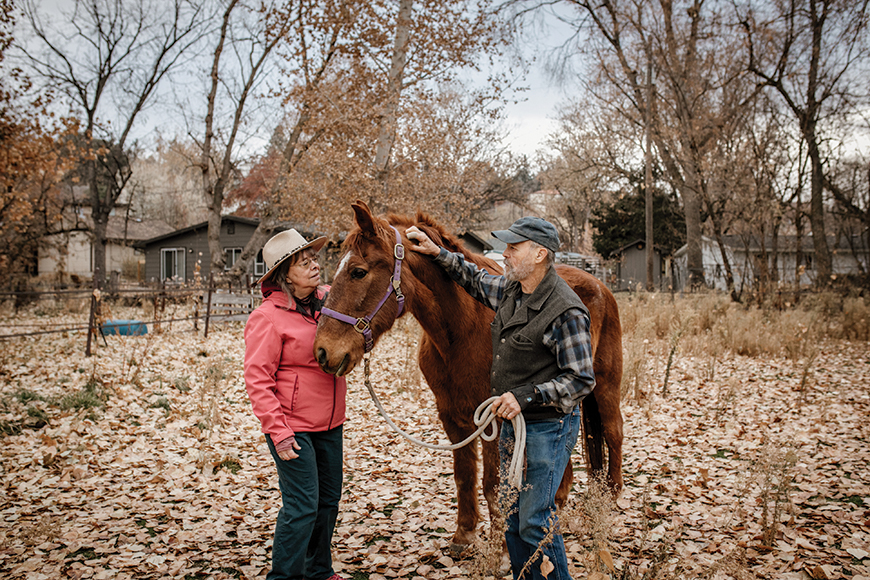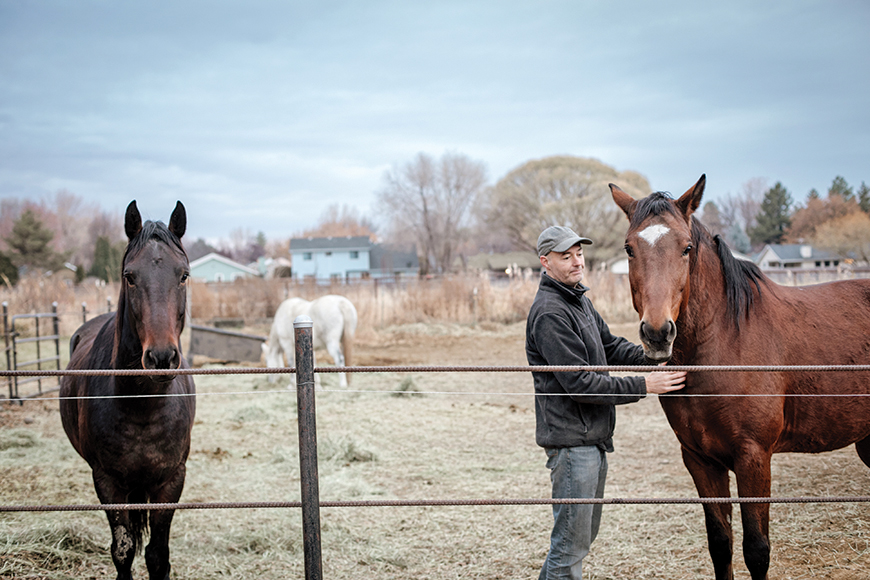At sunrise, there are horses in the heart of Boise who stomp and snort for their hay ration, and people who pull on their barn boots to deliver it. Horse and rider meet and greet each other like the old friends they are, and both seem to sigh with pleasure: “This is how I want to live my days.”
In Boise, a small city with many people who came from rural areas and “grew up on the back of a horse,” horses are not kept on sprawling ranches with endless pastures and wide-open spaces. Small horse properties, once plentiful in many neighborhoods, are harder to find than ever. Some have been sold and developed for houses or apartments. Expensive horse setups with mansions and designer barns proliferate on the west side of the Treasure Valley: in Meridian, Eagle, Star, and points surrounding. But in the core of Boise city limits—on the Bench, the North End, and along Boise Avenue—there are still a few small properties with a corral and a small barn or shelter.
Pam and Chad Blackledge’s three-acre property along the northern edge of Boise is fronted by an arched iron sculpture naming the horse corral and pasture “Alma Cheia,” which is a Portuguese phrase meaning “full and joyful spirit and soul.” It’s alive with wildflowers, grass, and clover, and three beautiful horses who graze on the late-summer growth.
Formerly residents of Southeast Boise, the Blackledges snapped up the horse property five years ago. “It was very old and neglected, so we gutted the house and added a real barn with stalls to the ancient shelter that was here,” Pam said. The pastures were run down and overgrown, so they rehabilitated them and added goats, who are friends for the horses. A charming, funky chicken house is nestled under an enormous weeping willow, and a cat named Jeebs—”who just showed up”—sleeps on a deck chair.
An inspiring example of the unique bond between human and horse, Pam and her three horses exude a near reverence for each other. Pam describes herself as a body wellness practitioner who uses various types of massage to help people heal, and she never stops touching and rubbing the horses with obvious skill. They soak it up and acknowledge her with happy snorts and nodding heads.

Gail Heylmun and Gary Sandusky get ready for a late fall ride. Photo by Amanda Rene Photography.
A mile or so southeast and hidden behind old trees, Gail Heylmun and Gary Sandusky bought their property in 1993. It was once semi-rural, but is now suburban. They wanted a big garden and irrigation water as well as room for their horses. Their 1920s lot with huge trees is a charming mash-up of house, old-fashioned barn, several other old outbuildings, a fruit orchard, and a corral. Their Tennessee Walking Horse is Teddy, a longtime and loved family member who lived in this paradise with his pal Goldie, who died of old age not long ago. For a time, two Arabians from next door boarded in.
Well known in Boise, Gary and Gail are both nonprofit executives, and both are also musicians, which shows on their wall of beautiful guitars. They raised their three boys here, the whole family sharing the responsibility and joy of their horses.
Gary, who does most of the riding, takes Teddy to the North Eagle foothills, an area west of Boise proper, and Spring Valley Ranch nearby. “That whole ranch area has been controlled by a couple of different development companies and is slated for significant housing development. But to date, it is still a great place to get out and encounter very few people.”
With the steadily increasing population and housing development of Boise, some horse properties and riding arenas have been swallowed up. Jean McNeil, who has three acres in Boise’s North End, said, “There is the question of where to ride, especially in the city. We are fortunate to have access to a canal bank and to the foothills not far away. McNeil said some people use an arena on 36th Street. “It’s a city facility and the only open-to-the-public riding arena in city limits.”
But for 17 years, McNeil and her family had a free arena directly across the street on a tree farm. The farmer gave them permission to build their own arena on his land “for $1 a year!” said McNeil. Eventually, however, the farm was sold and became a housing development. “Now all I see out my window are rooftops,” she said, clearly dejected. But she, along with other horse lovers who keep small horse properties alive, and the many horse clubs and organizations in the Treasure Valley, clearly haven’t forfeited the idea of living with horses in the city.

